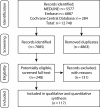Inequality in Utilization of Dental Services: A Systematic Review and Meta-analysis
- PMID: 29267052
- PMCID: PMC5846590
- DOI: 10.2105/AJPH.2017.304180
Inequality in Utilization of Dental Services: A Systematic Review and Meta-analysis
Abstract
Background: Dental diseases are among the most prevalent conditions worldwide, with universal access to dental care being one key to tackling them. Systematic quantification of inequalities in dental service utilization is needed to identify where these are most pronounced, assess factors underlying the inequalities, and evaluate changes in inequalities with time.
Objectives: To evaluate the presence and extent of inequalities in dental services utilization.
Search methods: We performed a systematic review and meta-analysis by searching 3 electronic databases (MEDLINE, Embase, Cochrane Central Database), covering the period from January 2005 to April 2017.
Selection criteria: We included observational studies investigating the association between regular dental service utilization and sex, ethnicity, place of living, educational or income or occupational position, or insurance coverage status. Two reviewers undertook independent screening of studies and made decisions by consensus.
Data collection and analysis: Our primary outcome was the presence and extent of inequalities in dental service utilization, measured as relative estimates (usually odds ratios [ORs]) comparing different (high and low utilization) groups. We performed random effects meta-analysis and subgroup analyses by region, and we used meta-regression to assess whether and how associations changed with time.
Main results: A total of 117 studies met the inclusion criteria. On the basis of 7 830 810 participants, dental services utilization was lower in male than female participants (OR = 0.85; 95% confidence interval [CI] = 0.74, 0.95; P < .001); ethnic minorities or immigrants than ethnic majorities or natives (OR = 0.71; 95% CI = 0.59, 0.82; P < .001); those living in rural than those living in urban places (OR = 0.87; 95% CI = 0.76, 0.97; P = .011); those with lower than higher educational position (OR = 0.61; 95% CI = 0.55, 0.68; P < .001) or income (OR = 0.66; 95% CI = 0.54, 0.79; P < .001); and among those without insurance coverage status than those with such status (OR = 0.58; 95% CI = 0.49, 0.68; P < .001). Occupational status (OR = 0.95; 95% CI = 0.81, 1.09; P = .356) had no significant impact on utilization. The observed inequalities did not significantly change over the assessed 12-year period and were universally present.
Authors' conclusions: Inequalities in dental service utilization are both considerable and globally consistent. Public Health Implications. The observed inequalities in dental services utilization can be assumed to significantly cause or aggravate existing dental health inequalities. Policymakers should address the physical, socioeconomic, or psychological causes underlying the inequalities in utilization.
Figures
References
-
- Petersen PE. World Health Organization global policy for improvement of oral health—World Health Assembly 2007. Int Dent J. 2008;58(3):115–121. - PubMed
-
- Di Cesare M, Khang YH, Asaria P et al. Inequalities in non-communicable diseases and effective responses. Lancet. 2013;381(9866):585–597. - PubMed
-
- Batchelor P, Sheiham A. The limitations of a “high-risk” approach for the prevention of dental caries. Community Dent Oral Epidemiol. 2002;30(4):302–312. - PubMed
Publication types
MeSH terms
LinkOut - more resources
Full Text Sources
Other Literature Sources
Medical
Miscellaneous


